From Grain - August 2012
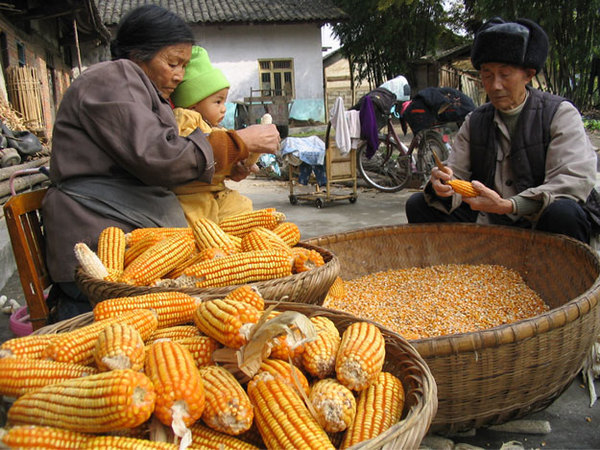 (Photo: Reuters)
(Photo: Reuters)When China began importing soybeans as animal feed in the late 1990s, it ushered in one of the most dramatic agricultural transformations the world has ever seen. On the other side of the world, 30 million hectares of farms, forests, savannahs and pastures in the Southern Cone of Latin America were converted to soy plantations to provide China’s new factory farms with a cheap source of feed. And within China, low prices paid to farmers and other policies favouring large agribusinesses pushed millions of households out of meat production. Corporations and large commercial farmers made fortunes, but rural communities, both in China and the Southern Cone, paid the price (see Box 1, 2 & 4).
Cheap meat for China’s growing urban population was supposed to be the payoff. But in 2008, prices for pork spiked because of a massive disease outbreak that swept through China’s pork industry, and now the country is on the verge of a more serious round of food inflation as a drought in the US causes global prices for soybeans to surge. On top of this, China’s consumers have had to contend with numerous food safety scandals and environmental disasters brought about by the shift to industrial meat production.
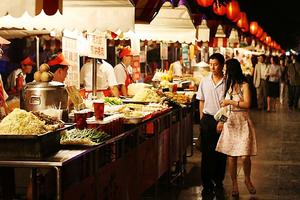 This year China surpassed the US as the world's largest grocery market. If the pace continues, Chinese consumers will spend US$1.6 trillion on groceries in 2015. (Photo: http://www.starfish-studio.com/2007/06/beijing-china.html)
This year China surpassed the US as the world's largest grocery market. If the pace continues, Chinese consumers will spend US$1.6 trillion on groceries in 2015. (Photo: http://www.starfish-studio.com/2007/06/beijing-china.html)
The problems generated at home and abroad by China’s growing dependence on imports of feed crops will get much worse if China continues to open its market to imports of maize, the other major crop used for industrial feeds. In 2012, China will import a record five million tonnes of maize, and it is on track to buy another seven million tonnes in 2013. This is only around 5% of national maize consumption, but it is still more maize than China imported during all previous 25 years combined and it is already affecting global prices.[1]
China is now the world’s largest global food market. What Chinese people eat has repercussions on everyone, because of the increasingly global reach of how and where that food is produced. If the Chinese government opens the country up to maize imports as it did with soybeans, it could unleash another global agricultural transformation on par with what occurred with soybeans. Recent developments show that this is already starting to happen.
Power plays for China’s maize supply
China’s soybean imports have generated immense profits for transnational agribusiness companies like Monsanto and John Deere, who supply Brazilian farmers with seeds, chemicals and tractors. And they have been a deep source of profit for grain traders and feed processors like Cargill and Bunge who now control China’s soybean processing industry.
The shift to factory farms and soybean imports has also enabled the rise of a new class of Chinese agribusiness corporations. State-owned COFCO and privately-held New Hope Group are now transnational agribusiness corporations in their own right.
A soybean-style boom in maize would suit all of these companies very well and they are lobbying heavily for it while they prepare the terrain.
Figure 1. China's soy and maize imports
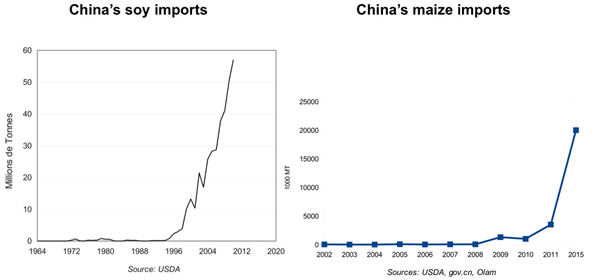
If these corporations get their way, the Chinese government will reduce or eliminate the quotas and other measures which until now have protected domestic production of maize from cheaper imports. China’s consumption of soybeans ballooned by more than 160% between 2000 and 2011 when import barriers were removed, but the area planted with soybeans declined by 20% during those same years. Chinese farmers were simply unable to compete with imported soybeans that were RMB 300 to 600 (US$45-90) cheaper per tonne than domestic be[b]ans. Imported soybeans now account for three-quarters of the soybeans processed into cooking oil and feed in China, the products of soybean crushing.[2]
In contrast, during the same period, China protected and regulated maize as a strategic crop for food security. As consumption increased, so did local production. Between 2000-2011, the area planted with maize rose by 44% and yields by 25%.[3]
The more maize China imports, the more it will undercut its own farmers and the more it will require from overseas.
But where will these new supplies come from? The US, with its subsidised maize production, is an essential source for Chinese demand in the near term, which explains why Japan's Marubeni paid a startling US$5.8 billion to take over US grain trader Gavilon in May 2012. But, as this year's drought in the US has underlined, geographic diversity of supply matters. In the year before taking over Gavilon, Marubeni signed a cooperation agreement with China's New Hope to work together in developing operations in Africa, the Middle East, Eastern Europe and South America, it bought a grain elevator in Brazil and it entered into a joint venture with China's state grain trader Sinograin to establish feed plants and pig farms in China.
“We will expand in Latin America, maybe eastern Europe, Australia and Africa,” says Daisuke Okada, head of Marubeni’s foods division. “So if we think about future demand in China, we need to have more certainty of supply.” Okada expects increased demand for feed will quadruple China’s imports of maize to 15 million or 16 million tonnes by 2020, while its imports of soybeans will increase from 60 million to 90 million.[4]
Chinese corporations are also making moves to control the supply of agricultural commodities going to China. COFCO, China's biggest grain trader as well as one of its largest meat and dairy companies, is exploring investments in grain and soybean production and trading logistics in Russia, Brazil and Argentina. Chongqing Grain has put aside US$6 billion to invest in grain and oilseed production and trade in Argentina, Brazil, Canada and other countries. Beidahuang, China's largest farming company, says it has started planting soybeans on 13,000 ha in Argentina, and intends to expand further through a partnership with the country’s biggest farmland owner (see Box 3).
 "China has 800 million farmers, of which 300-400 million are moving to cities. That will increase the demand for agricultural products and decrease the supply. This is positive for agricultural companies, like us," says New Hope Group President Liu Yonghao, China’s fourth richest person and Vice-Chairman of the Committee for Economic Affairs of the Chinese People's Political Consultative Conference. Liu wants China to open its maize market as it did with soybeans, by changing maize's classification to a non-strategic crop for food security
"China has 800 million farmers, of which 300-400 million are moving to cities. That will increase the demand for agricultural products and decrease the supply. This is positive for agricultural companies, like us," says New Hope Group President Liu Yonghao, China’s fourth richest person and Vice-Chairman of the Committee for Economic Affairs of the Chinese People's Political Consultative Conference. Liu wants China to open its maize market as it did with soybeans, by changing maize's classification to a non-strategic crop for food security
New Hope, the largest privately-owned agribusiness company in China, has gone the furthest in its overseas expansion. It owns 16 feed factories outside of China and plans to open 7 or 8 more per year. The company also plans to set up plants and farms in the Middle East, South Africa and Central Europe, backed by a fund launched in November 2011 which counts sovereign wealth fund Temasek (Singapore) and global grain traders ADM (US) and Mitsui (Japan) among its investors.
But global supplies of agricultural commodities are already tight and China is not the only country with an expanding appetite for them. China's neighbours, especially Japan, Korea and India, are also deeply concerned about their future food security, and they are making similar moves to support their companies in securing global supplies.
Meanwhile, the food deficit ( i.e. the difference between imports and exports of food) in Africa and the Middle East is actually larger and growing faster than it is in Asia, and the wealthier countries in the region, particularly the Gulf countries, are taking aggressive actions to secure control over food production outside of their borders.
Added to this is the growing demand for agrofuels, which competes for supplies of agricultural commodities, like maize, palm oil and sugar, as well as for the land on which crops can be grown for food. Globally, ethanol accounted for 27.3 percent of maize usage in 2011.[5]
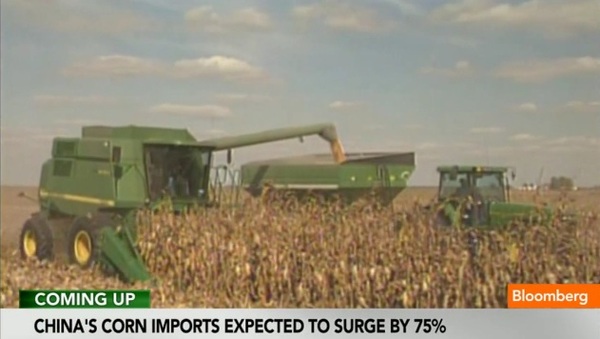 “I see China’s increasing demand for corn as inexorable,” says David Nelson of Rabobank, one of the biggest lenders to the farming industry and an investor in global farmland (see "Marubeni bets on China with Gavilon deal," Financial Times, 29 May 2012).
“I see China’s increasing demand for corn as inexorable,” says David Nelson of Rabobank, one of the biggest lenders to the farming industry and an investor in global farmland (see "Marubeni bets on China with Gavilon deal," Financial Times, 29 May 2012).The next frontier
Beyond these tussles for control over the current centres of export production, there is a big push to open up new frontiers for the low-cost production of maize, soybeans and other agricultural commodities, along the lines of what transpired in the Southern Cone of Latin America. With strong global demand, higher commodity prices are likely here to stay, and – at least in low-cost areas of production where there are possibilities for new large-scale farming operations – industrial agriculture is now seen as a profitable enterprise that many players, from pension fund managers to grain traders, want to get involved in.
Greg Page, the CEO of US-based Cargill, the world’s largest grain trader and one of the biggest exporters of agricultural commodities to China, thinks that 20% more of the world’s land will have to be converted to agricultural commodity production to match growing global consumption. He expects much of the increase will happen in Africa, on land currently cultivated by small farmers.
"The world has spent hundreds of billions of dollars in Africa and we have nothing to show for it in terms of small producers," argues Page. "We need their acres, but we need to do it thoughtfully."[6]
Large swaths of the African continent are being eyed as the new Brazilian cerrado, a place where companies can take advantage of low prices for fertile land, water and labour to produce commodities for export on a large-scale. Parts of Eastern Europe, Colombia, Central Asia and Southeast Asia are targets too. The International Land Coalition calculates that since 2002, 83.2 million hectares or 1.7% of the world’s agricultural land has been acquired by foreign investors for agricultural production, with over 60% of these land deals happening in Africa.
In the process, communities are being displaced, millions of people are losing access to water, and local food systems are being destroyed to make way for exports. The opening of the next frontiers for agricultural commodity production is well under way. More maize exports to China will only add fuel to a fire that is burning out of control.
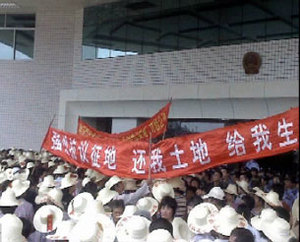 Residents of Nanwan village in southern Guangdong province protest outside a government building against alleged corruption surrounding a farm built on their land.
Residents of Nanwan village in southern Guangdong province protest outside a government building against alleged corruption surrounding a farm built on their land.A simple solution
The world does not need to go down this path. In the face of yet another spike in prices for global agricultural commodities, China can put the brakes on industrial meat production, start supporting small scale livestock farming based on local feed resources, and ends its aggressive efforts to convert farmers into cheap labourers.
Protests in rural China seem to indicate that many smallholder farmers are fed up with being pushed off of their farms, having their land and water poisoned by industrial and agricultural pollution, and struggling to make ends meet. They are capable of producing the food necessary to feed their country, but face increasingly difficult barriers, most of which are associated with a corporate food system that is becoming evermore firmly entrenched.
Government decisions to rely on agricultural commodity imports serve the interests of agribusiness and its need for cheap sources of feed, but they are not in the interest of the majority of Chinese people, do not serve to secure their food needs and threaten the land, livelihoods and local food systems of communities across the globe.
Box 1: From farms to factories
Ten years ago in China’s main pork producing provinces Fujian, Guizhou, Hainan, Hunan or Jiangsu, you would be hard pressed to find a household that didn’t keep half a dozen pigs. Today such homes are rare.
Despite government subsidies and rising meat prices, the number of Chinese households raising pigs dropped by half in 2008 alone, and has continued to decline ever since. People in China’s cities may be eating more pork, but villagers are eating – and earning – less.[7]
China’s 200 million farming households have average incomes less than a third of their urban counterparts and it is hard to find evidence of China’s booming meat consumption in the average Chinese village.
Yet pigs have long been central to life in much of rural China. They have enabled families to convert kitchen waste and farm residue into meat for sale or household consumption and into manure for their fields. But low prices and policies favouring large farms and urban migration have forced many Chinese households to give up their pigs. Now factory pig farms dot the countryside, spewing enormous quantities of waste that they cannot safely dispose of.
One of the consequences of this shift to factory farms, not only for pigs but also for poultry and other livestock, has been a massive growth in demand for industrial animal feed. The average pig raised in a Chinese factory farm eats around 350 kg of grain to grow to slaughter, while a pig raised on a Chinese family farm eats only 150 kg because it also consumes household waste and other non-grain, local feed sources. China is not only eating more meat these days, its farm animals are eating more crops – much more than what is produced in China.[8]
Figure 1. Share of total pig production in China by farm type, 1985-2007 (%).
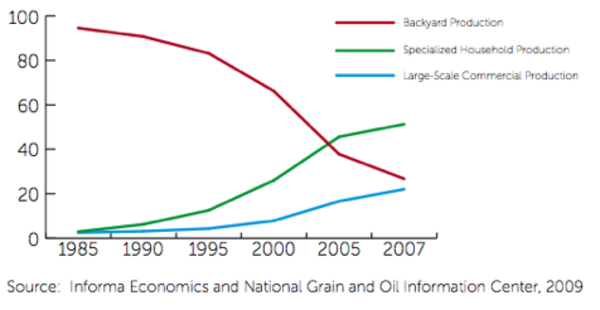 |
Box 2: Ripple effects
Ituzaingó is just one of the communities affected by the massive expansion in soybean production in the Southern Cone of Latin America that followed from the opening of China’s soybean market to imports in the late 1990s.
"We used to have farms, and cows and fruit trees," says Sofía Gatica, a resident of the community of Ituzaingó, Argentina. "But they destroyed all that and planted genetically modified soybeans."[9]
 The Mothers of Ituzaingó, cofounded by Sofía Gatica,launched a “Stop Spraying” campaign to warn the public about the dangers of pesticides. The Mothers of Ituzaingó, cofounded by Sofía Gatica,launched a “Stop Spraying” campaign to warn the public about the dangers of pesticides.
Ituzaingó is just one of the communities affected by the massive expansion in soybean production in the Southern Cone of Latin America that followed from the opening of China’s soybean market to imports in the late 1990s.
Like other communities in the path of the soy boom, Ituzaingó lost more than just local food production. Every year in Argentina over 50 million gallons of pesticides are aerially sprayed on soybeans. Because of the aerial spraying of pesticides on the surrounding soybean fields, its cancer rate is now 40 times Argentina’s national average. Sofía Gatica's daughter died when she wa[c]s three days old from kidney failure caused by exposure to pesticides.
|
Box 3: Some Chinese companies with overseas agriculture projects
Chongqing Grain Group (CGG)
State-owned CGG has set aside US$3.4 billion for an overseas expansion that includes a 200,000 ha soybean farm in Brazil, a 130,000 ha soybean farm in Argentina's Chaco province, and plans to produce oilseed rape in Canada and Australia, rice in Cambodia and palm oil in Malaysia.
Beidahuang
State-owned Beidahuang manages over 2 million ha of farmland in the province of Heilongjiang. In Argentina, it is pursuing a partnership with Cresud, the country’s largest farming company, to acquire farmland. A US$1.4-million deal it signed with the governor of Río Negro province to secure a supply of soybeans, maize and other crops for 20 years from farms covering 320,000 ha was suspended by court order. Beidahuang is awaiting approval for a project to develop 200,000 ha of rice, maize, and other crops in the Philippines and is reported to have made offers on a number of farms in Western Australia, amounting to about 80,000 ha of land. Heilongjiang Province, meanwhile, has leased 426,667 ha of land in Russia.
Sanhe Hopeful
Privately owned Sanhe Hopeful says it will invest US$7.5 billion in the Brazilian state of Goias to secure six million tons of soybeans per year. It also has a joint venture with Argentine businessman Francisco Macri to produce and ship soybeans from Argentina's Northwest through the port of Santa Fé.
ZTE Corp
ZTE, China's largest telecommunications company, acquired 30,000 ha of oil palm plantations on Indonesia's Kalimantan Island, 50,000 ha for cassava production in Laos, and a 10,000 ha farm in Sudan for maize and wheat. In the Democratic Republic of the Congo it has two pilot farms and a 100,000 ha concession for an oil palm plantation that it has yet to develop.
Pengxin Group
Shanghai real-estate company Penxin Group invested more than US$20 million in a 12,500 ha Bolivian soybean and maize farm, established large-scale farms in Cambodia and Argentina, is negotiating to buy 200,000 ha of land in Brazil for soybeans and cotton, and purchased 16 dairy farms in New Zealand.
Tianjin State Farms Agribusiness Group Company
Tianjin State Farms acquired 2,000 ha of land in Bulgaria to grow maize, alfalfa and sunflower for export to China and is pursuing negotiations for a further 10,000 ha.
Shaanxi State Farm
Shaanxi State Farm signed a US$120-million investment agreement with the government of Cameroon that includes a long-term lease on 10,000 ha of land where the company intends to produce rice, maize, and cassava.
|
Box 4: Major impacts of the industrialisation of meat production in China
Industrialisation of livestock production, combined with liberalisation of the soybean sector, have resulted in a number of serious consequences for the environment, public health, and smallholder farmers. The following is a summary of five major impacts, all of which challenge the notion that industrial agriculture can solve food security needs now or in the future.
Environmental impacts
1. The massive increase of animal waste from industrial livestock operations is the main source of water pollution in China today. China's first pollution census – conducted in 2012 – found that the combined impacts of livestock farming and fertiliser and pesticide runoff from fields, surpassed industry as the county’s biggest source of water pollution. Rural people who depend on polluted waterways for household and agricultural use are worst affected in the short-term, but the dead zone that has developed in the East China Sea from excess nitrogen and phosphorus – directly related to industrial meat production – is a sign of larger-scale ecological crises in the longer term.
2. Industrial meat production also contributes significantly to increased greenhouse gas emissions, to the steep decline in indigenous livestock breeds and native soybean varieties, and to the emergence of antibiotic-resistant bacteria that threaten human and animal health.
Health and dietary impacts
1. Food safety has become a hot button issue in China along with the industrialisation of agriculture in general and livestock production in particular. From the highly publicised melamine milk scandals and animal feed and meat recalls, to the heavy metal, pesticide, and mycotoxin residues commonly found in meat, food safety issues are endemic to today’s industrial meat industry.
2. China's urban middle- and upper-classes are eating more meat, more often while spe[d]nding a declining share of household income on food . Rural residents, on the other hand, eat only half as much meat as their urban counterparts, but spend a larger share of their income on food (43.7% of rural income, versus 37.9% of urban income). In a sign of this growing inequality, urban Chinese are suffering increasingly from diet-related diseases of affluence (coronary heart disease, type 2 diabetes, obesity, and a range of cancers), while meat remains a luxury to many in rural China, where 150 million people fall below the US$1.25 per day poverty guideline, with another 140-230 million (20-30% of the rural population) precariously close to joining them in cases of illness, natural disasters, or economic recession.
Smallholder and rural livelihood implications
1. Smallholder farmers living in China’s vast rural regions are most vulnerable as a group to the livelihood transformations that result from the industrialisation of meat production. In the new agribusiness-led meat economy, smallholder livestock farmers struggle for market access against severe disadvantages in terms of evolving meat quality standards that favour leaner pork, safety requirements based on international standards, and the structure of state subsidy programs that provide support to the agriculture industry. Concurrently, small-scale soybean farmers are faced with cheap GM imports, a struggling domestic soybean crushing industry, and infrastructural challenges of getting their harvest to potential markets. These farmer households are continually losing money, and many have already had to give up livestock and/or soybean production.
(This box was written by Mindi Schneider and is based on her study “Feeding China’s Pigs: Implications for the Environment, China’s Smallholder Farmers and Food Security,” IATP, May 2011)
|
Going Further:
GRAIN, “Big Meat is growing in the South,” October 2010: http://www.grain.org/e/4044.
GRAIN, New agricultural agreement in Argentina: a land grabber’s “instruction manual”, 27 January 2011: http://www.grain.org/e/4139
Mindi Schneider, “Feeding China’s Pigs: Implications for the Environment, China’s Smallholder Farmers and Food Security,” IATP, May 2011: http://www.iatp.org/documents/feeding-china%E2%80%99s-pigs-implications-for-the-environment-china%E2%80%99s-smallholder-farmers-and-food
_______________
[1] "Marubeni bets on China with Gavilon deal," Financial Times, 29 May 2012.
[2] For a more detailed discussion of China’s moves to allow in soybean imports, see Mindi Schneider, “Feeding China’s Pigs: Implications for the Environment, China’s Smallholder Farmers and Food Security,” IATP, May 2011: http://www.iatp.org/documents/feeding-china%E2%80%99s-pigs-implications-for-the-environment-china%E2%80%99s-smallholder-farmers-and-food
[3] Gabe Collins and Andrew Erickson, “Tilling Foreign Soil: New Farmland Ownership Laws Force Chinese Agriculture Investors to Shift Strategies in Argentina and Brazil,” China SignPost, No. 57, 28 March 2012.
[4] Ben McLannahan, “Marubeni eyes more deals to supply China,” Financial Times, 27 June 2012.
[5] US National Corn Grower's Association's World of Corn report 2011
[6] http://www.naplesnews.com/news/2012/apr/13/cargill-ceo-says-food-shortage-fears-unfounded/
[7] China’s National Bureau of Statistics reports that rural people’s annual consumption of pork per person dropped from 15.62 kg in 2005 to 13.37 kg in 2007.
[8] The information in this box comes primarily from Li Jian, “The Decline of Household Pig Farming in Rural Southwest China: Socioeconomic Obstacles and Policy Implications,” Culture & Agriculture Vol. 32, Issue 2, 2010.
[9]http://www.goldmanprize.org/recipient/sofia-gatica



No comments:
Post a Comment